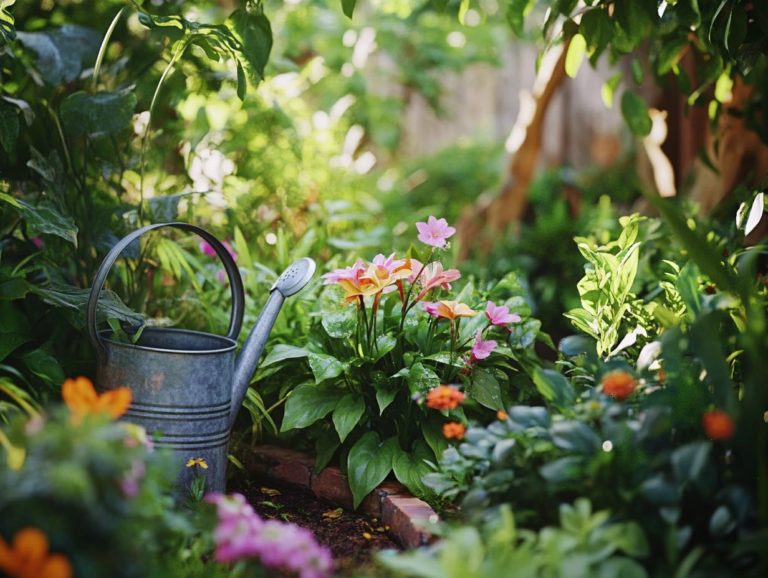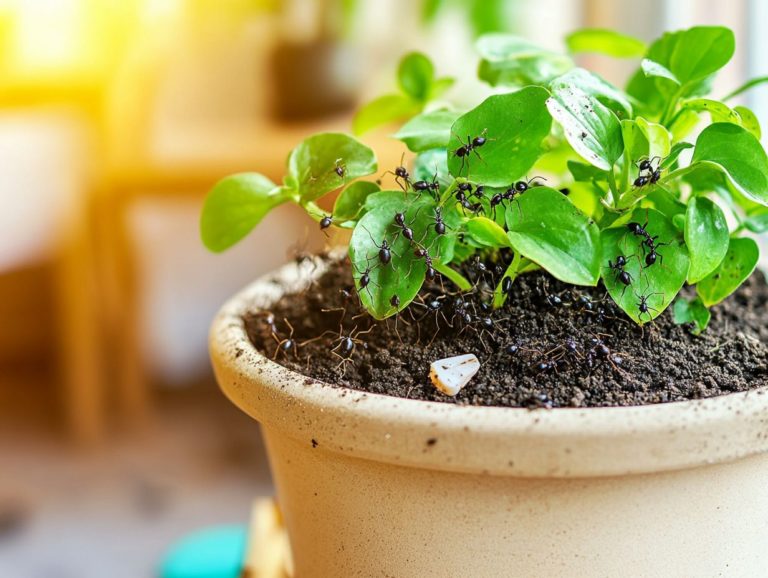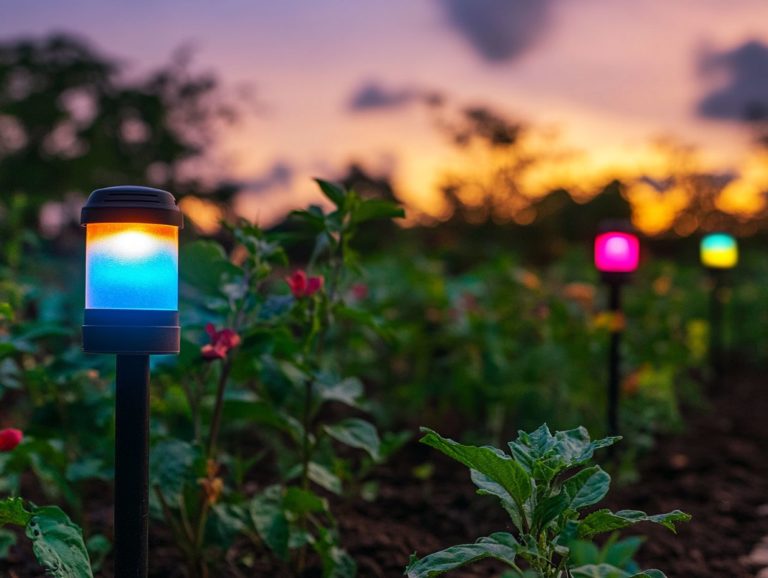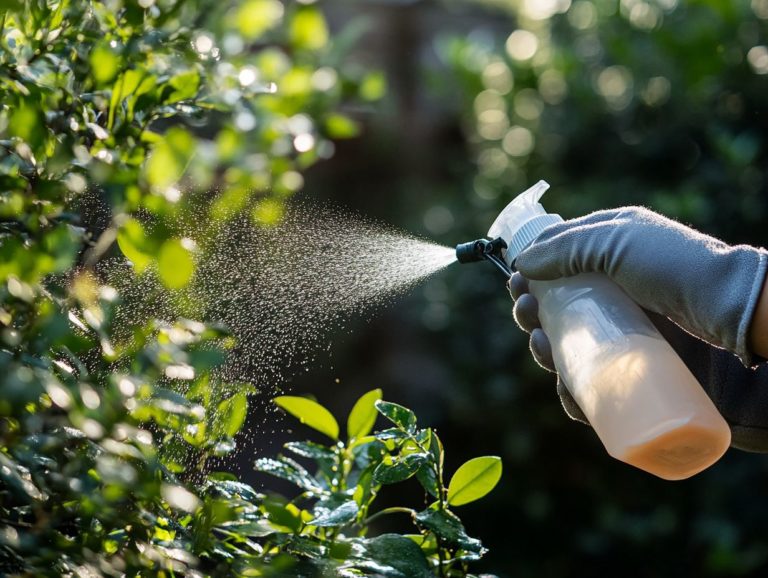How to Remove Aphids from Indoor Plants
Aphids are those minuscule pests that can cause significant damage to your indoor plants. They often lurk in the shadows until the situation spirals out of control.
To truly safeguard your green companions, knowing your enemy is your best defense against these pests! Understanding who these pests are, the havoc they can wreak, and how to spot their presence before it’s too late is essential.
This guide will illuminate the signs of an aphid infestation, offer effective removal methods ranging from non-toxic solutions to chemical options and provide valuable tips for preventing future outbreaks.
With just a bit of knowledge and effort, you can ensure that your indoor garden remains vibrant and completely aphid-free!
Contents
- Key Takeaways:
- Understanding Aphids and Their Impact on Indoor Plants
- Identifying and Monitoring for Aphids
- Removing Aphids from Indoor Plants
- Preventing Future Aphid Infestations
- Frequently Asked Questions
- What are aphids and why are they harmful to my indoor plants?
- How can I identify if my indoor plants have aphids?
- What is the most effective way to remove aphids from my indoor plants?
- Can I use chemical pesticides to get rid of aphids on my indoor plants?
- How can I prevent aphids from infesting my indoor plants in the future?
- Are there any plants that naturally repel aphids?
Key Takeaways:
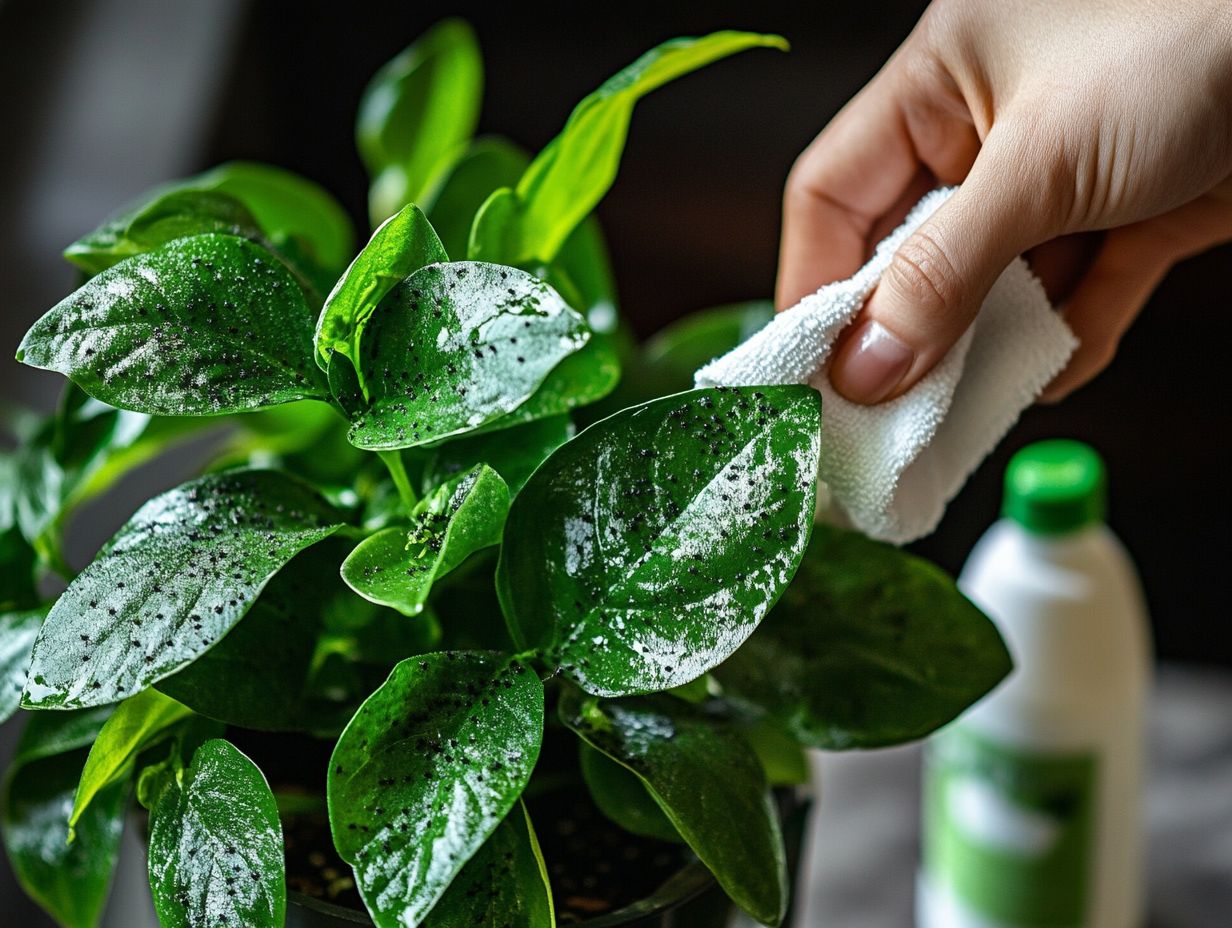
- Check your indoor plants regularly for any signs of aphids.
- Use non-toxic methods like manual removal, insecticidal soap, and neem oil to eliminate aphids.
- Maintain a healthy environment for your plants and use natural repellents and barriers to prevent future infestations.
Understanding Aphids and Their Impact on Indoor Plants
Aphids are tiny, soft-bodied insects that can wreak havoc on your houseplants. They re among the most common indoor plant pests, notorious for how fast they reproduce.
If left unchecked, they can quickly turn a minor issue into a full-blown infestation. Signs include curled leaves, stunted growth, and an unwelcome sticky substance called honeydew.
This goo not only attracts other pests but can also foster fungal growth, creating a perfect storm for your beloved plants.
Identifying and controlling aphids is essential for keeping your indoor greenery thriving, especially in urban areas like Indianapolis, where access to outdoor gardens can be limited and pest issues might worsen.
What are Aphids?
Aphids, commonly known as greenfly, are tiny insects that belong to the order Hemiptera and the family Aphidoidea.
These little critters come in various colors think green, black, and yellow and boast numerous species, each with unique traits. They have a reputation for their feeding habits; equipped with specialized mouthparts, they draw out nutrients from plants.
This feeding can hinder growth and, in some unfortunate cases, even lead to the demise of your beloved greenery.
Their rapid reproduction is another concern, with some species capable of giving birth to live young, making infestations a frequent headache for gardeners and indoor plant aficionados alike.
Despite their pesky nature, aphids play a crucial role in ecosystems; they serve as food for beneficial insects like ladybugs. They also act as vectors for plant diseases, which can significantly impact agricultural practices. Understanding their dual nature can help you navigate your gardening journey more effectively.
Damage Caused by Aphids
Aphid damage presents itself in several unmistakable ways, such as yellowing leaves, wilting, and stunted growth clear indicators of an aphid infestation.
These minuscule pests feast on plant sap, drawing out essential nutrients that undermine the vitality of your houseplants. As they indulge, they produce honeydew, a sticky residue that fosters the growth of sooty mold.
This mold can obstruct photosynthesis and attract even more pests, setting off a chain reaction detrimental to your plants’ health.
To combat this issue, it s imperative for you to regularly check for these pests and apply control measures like insecticidal soap or neem oil.
By upholding rigorous plant care and hygiene practices, you can effectively deter future infestations and safeguard your green companions.
Identifying and Monitoring for Aphids
Effective identification and monitoring for aphids are crucial for maintaining the health of your houseplants. Early detection allows you to prevent extensive damage from these persistent pests, ensuring your plants thrive.
Act now to protect your plants and enjoy a thriving indoor garden!
Signs of Aphid Infestation

The signs of aphid infestation can be quite subtle. They often manifest as curled or distorted leaves, sticky residues known as honeydew, and the unwelcome appearance of sooty mold on your plant surfaces.
You might also observe a noticeable decline in plant vigor or stunted growth. These pesky critters drain vital nutrients, which can harm your plants. Typically, aphids can be found clustered on the undersides of leaves, making them easy to overlook.
Keep an eye out for ants nearby; their presence is a telltale sign since they are drawn to the honeydew that aphids produce.
To prevent infestations, inspect your plants regularly. Maintaining healthy soil is also essential. Introducing beneficial insects like ladybugs can be a game-changer.
Ensure proper air circulation and avoid over-fertilization. These steps deter pests and foster a resilient garden ecosystem.
Regular Inspection and Prevention
Regularly inspecting your houseplants is essential in the battle against aphids. It allows you to catch their presence early and apply effective prevention strategies.
Making this a weekly ritual can be immensely beneficial, helping you identify signs of infestation or unusual changes in plant health without delay. During these inspections, watch for yellowing leaves, sticky residue, or visible bugs each of these could signal an underlying issue.
Another best practice is to quarantine new plants for at least two weeks before adding them to your collection. This easy step reduces the risk of spreading pests. By maintaining optimal watering and light conditions, you can enhance your plants health, making them less vulnerable to pests and nurturing a flourishing indoor garden.
Removing Aphids from Indoor Plants
To remove aphids from your indoor plants, adopt a strategic approach that combines non-toxic methods with chemical solutions when necessary. This dual strategy ensures effective management of aphid populations while maintaining the health of your plants.
Non-toxic Methods
Non-toxic methods for removing aphids from your houseplants are safe and effective, allowing you to tackle infestations without harming your plants or the environment.
Take neem oil, for instance; it s an excellent way to disrupt the life cycle of these invaders. To use it, mix a few drops of neem oil with water in a spray bottle and thoroughly coat the infested areas of your plant, making sure to spray the undersides of the leaves where aphids love to hide.
Rubbing alcohol works wonders, too. A solution of 70% isopropyl alcohol can be dabbed directly onto the aphids with a cotton swab for an instant cure.
Consider using sticky traps around your plants as well; they’ll capture adult aphids and help you monitor the infestation. These environmentally friendly solutions tackle the immediate problem and serve as preventive measures against future outbreaks. For more tips on keeping your plants safe, check out preventing pest infestations in indoor plants, ensuring your beloved greenery remains healthy and thriving.
Chemical Solutions
When non-toxic methods fall short, consider chemical solutions such as insecticidal soap, spinosad, or products like Captain Jack’s Dead Bug Brew. These treatments offer a more aggressive approach to pest control, especially in severe infestations.
To apply these solutions effectively, adhere closely to the manufacturer’s instructions. Timing is everything; applying treatments during the late evening or early morning minimizes the risk of harming beneficial insects like bees.
Don’t overlook safety precautions; wearing gloves, goggles, and a mask protects you from skin irritation and respiratory issues. After applying any chemicals, keep a close eye on your plants’ health, as some substances can adversely affect beneficial insects and disrupt the natural ecosystem’s balance.
By understanding the broader implications of these treatments, you can maintain both the vitality of your plants and the biodiversity within your garden.
Start checking your plants today! Regular inspections and prompt action can help you protect your indoor plants from aphids and maintain a thriving garden.
Preventing Future Aphid Infestations
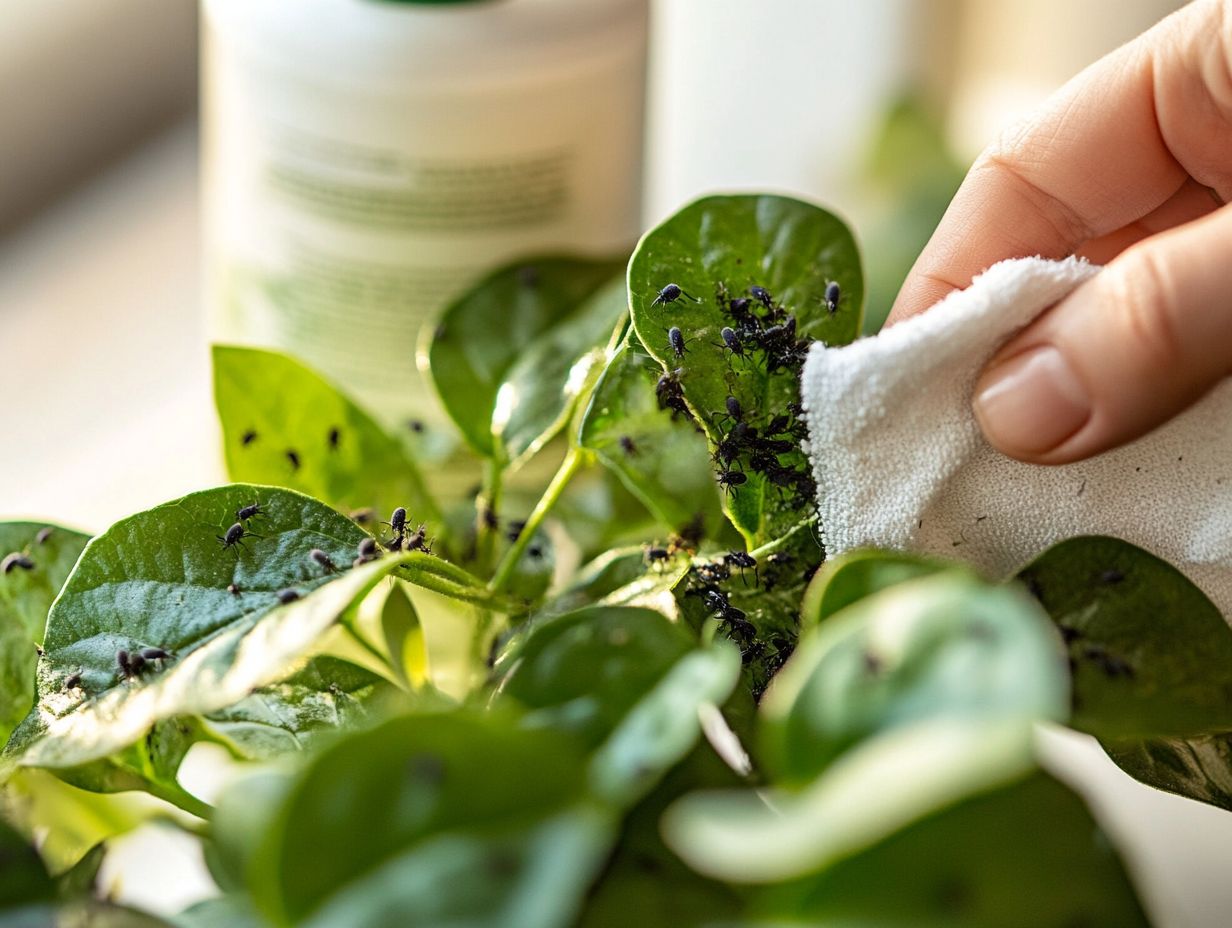
Preventing future aphid infestations is essential for maintaining a thriving indoor garden. It requires proactive efforts to cultivate an environment that is hostile to these pesky pests.
Maintaining a Healthy Environment for Plants
A healthy environment for your houseplants can significantly reduce the risk of aphid infestations and make them healthier.
Creating the right conditions starts with selecting the appropriate soil mix. This ensures proper drainage and enriches your plants with essential nutrients. Establishing a consistent watering schedule is also crucial. This allows you to monitor moisture levels carefully and prevent the pitfalls of overwatering or drought stress.
Understanding each plant’s light preferences—whether they thrive in bright, indirect sunlight or require low-light conditions—can influence their growth and resilience against plant pests. Additionally, knowing how to use neem oil for indoor plants can further help protect your greenery. By following these best practices, you can cultivate a flourishing indoor oasis that naturally deters common threats like aphids.
Natural Repellents and Barriers
Using natural repellents and barriers is an effective strategy to prevent aphid damage from infesting your indoor plants while avoiding harmful chemicals.
By using the strength of essential oils, like peppermint and lavender, you can create a fragrant yet uninviting environment for these pests. Companion planting—growing certain plants together to benefit each other—like marigolds or basil, not only masks the scent of more vulnerable plants but also attracts beneficial insects that serve as natural predators to aphids. For more effective strategies, consider managing whiteflies on houseplants.
Creating physical barriers like row covers or sticky traps can effectively stop these pests. These methods underscore the effectiveness of eco-friendly approaches and integrate into a broader pest management strategy focused on sustaining plant health and promoting biodiversity.
Frequently Asked Questions
What are aphids and why are they harmful to my indoor plants?
Aphids are small, soft-bodied insects that feed on the sap of plants, causing damage to leaves and stems. They can also transmit diseases to the plants, making them more susceptible to other pests or diseases.
How can I identify if my indoor plants have aphids?
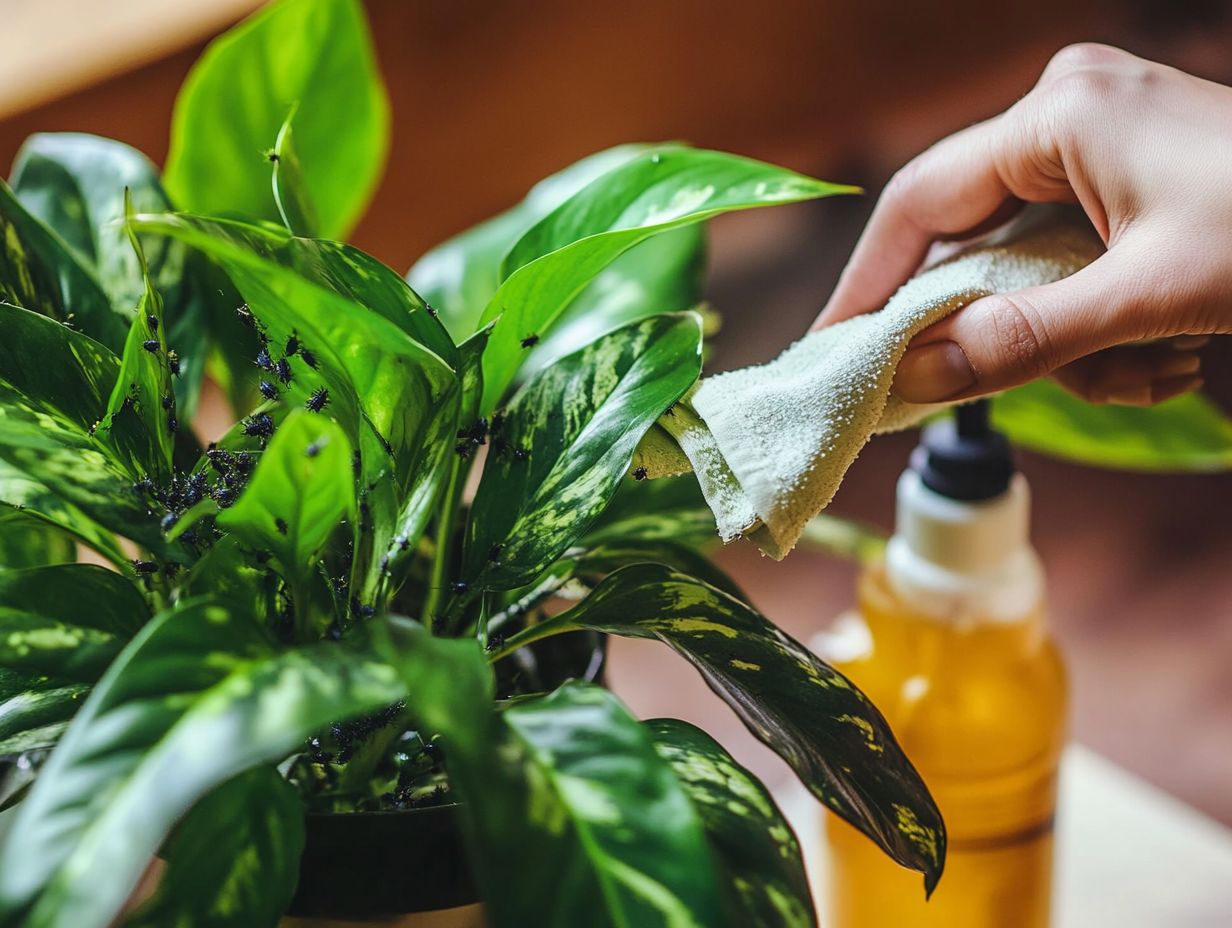
Look for clusters of small, green or black insects on the leaves and stems of your plants. You may also notice sticky residue on the leaves, which is a sign of aphid infestation.
What is the most effective way to remove aphids from my indoor plants?
One method is to physically remove the aphids by spraying a strong stream of water on the affected areas. You can also use a mild soap solution or neem oil spray to kill and repel the aphids.
Can I use chemical pesticides to get rid of aphids on my indoor plants?
While chemical pesticides may be effective in killing aphids, they can also harm beneficial insects and damage the environment. It is best to exhaust natural remedies before resorting to pesticides.
How can I prevent aphids from infesting my indoor plants in the future?
Regularly inspect your plants and remove any aphids you see immediately. You can also introduce natural predators of aphids, such as ladybugs, to your indoor garden. Keep your plants well-watered and fertilized to promote healthy growth and make them less vulnerable to pests.
Are there any plants that naturally repel aphids?
Yes, some plants, such as chives, garlic, and marigolds, are known to repel aphids due to their strong scent. Consider planting these around your indoor garden to help prevent aphid infestations.
Start implementing these strategies today to protect your indoor garden!


